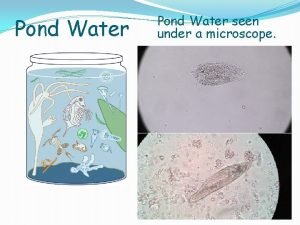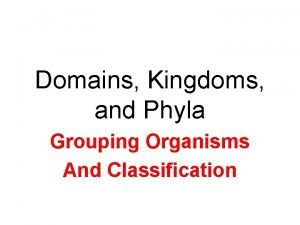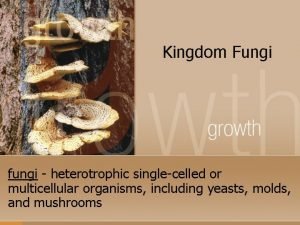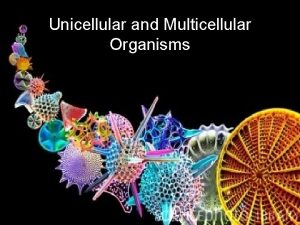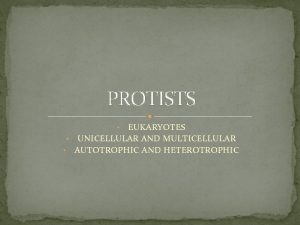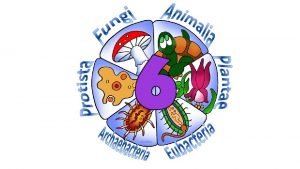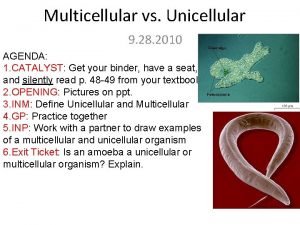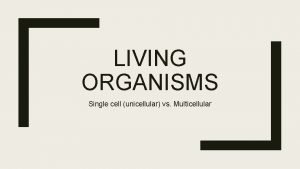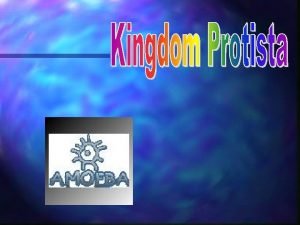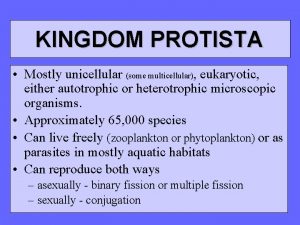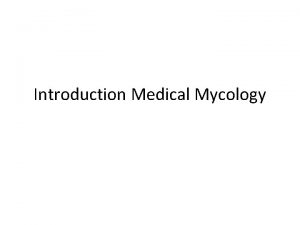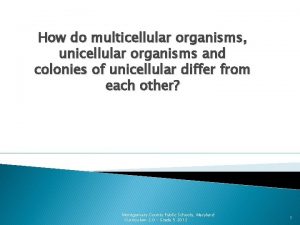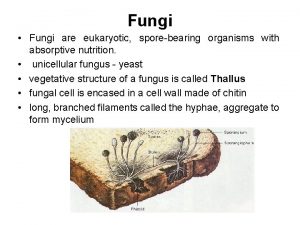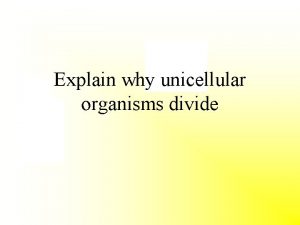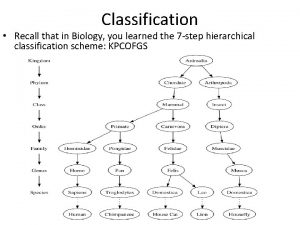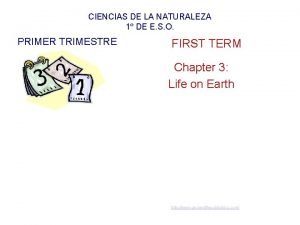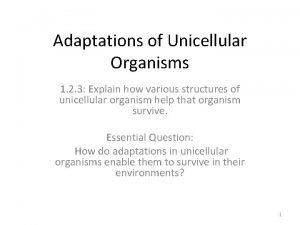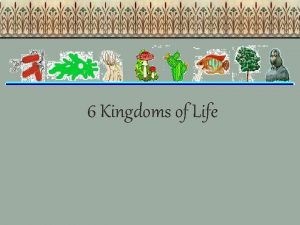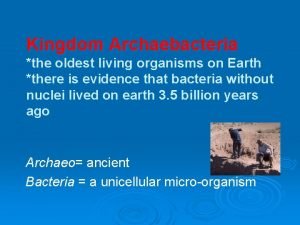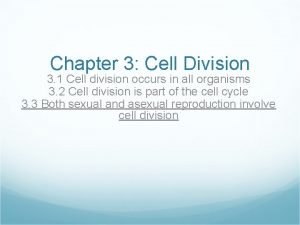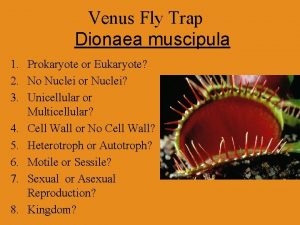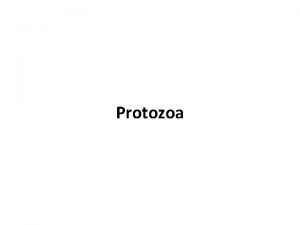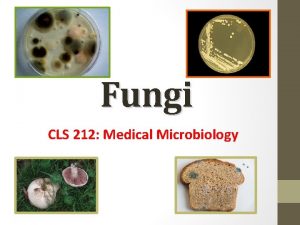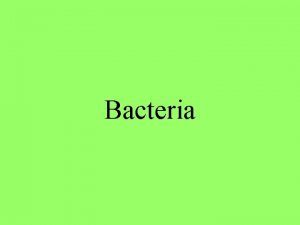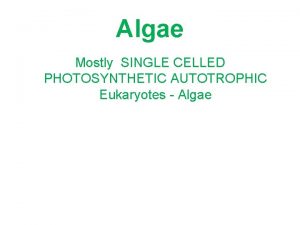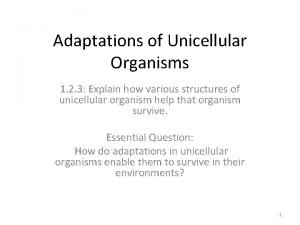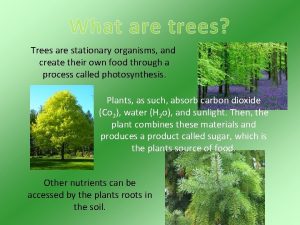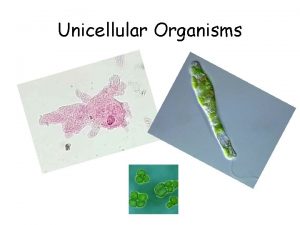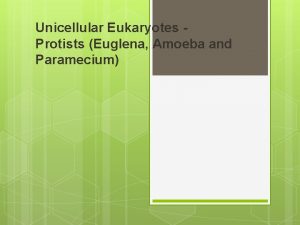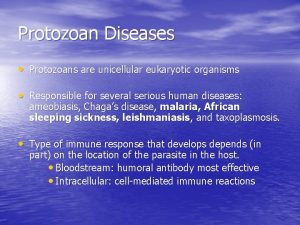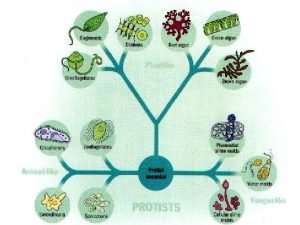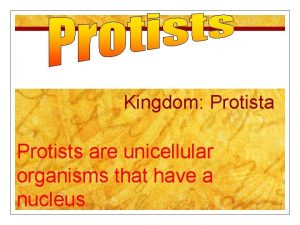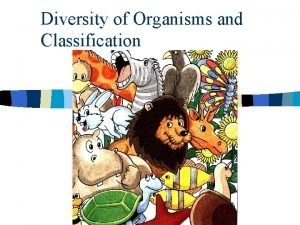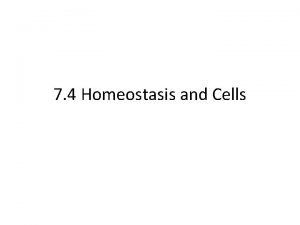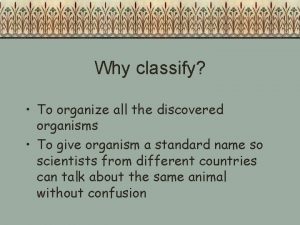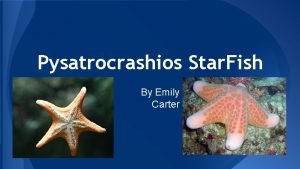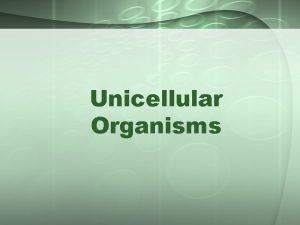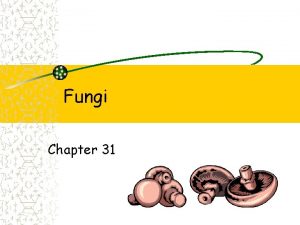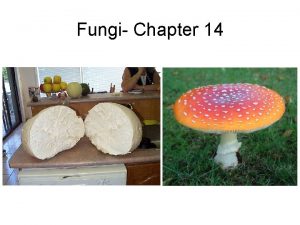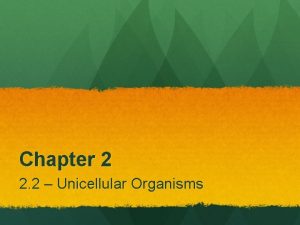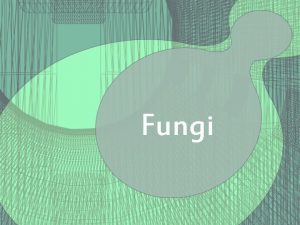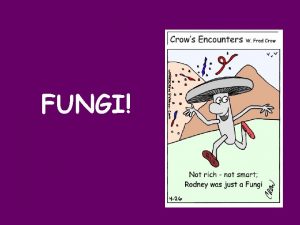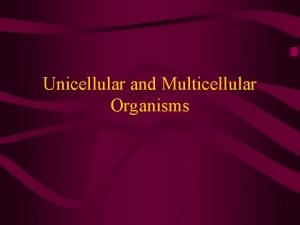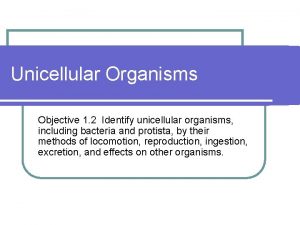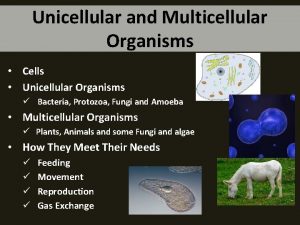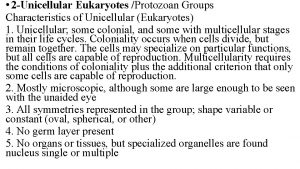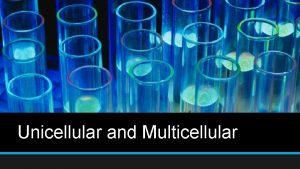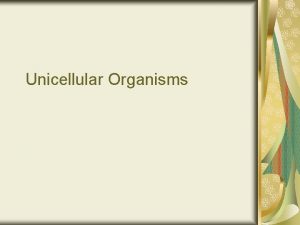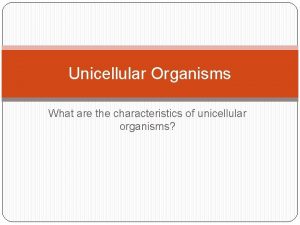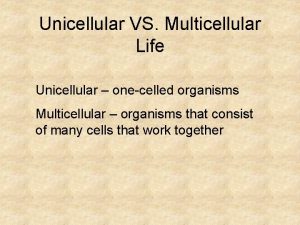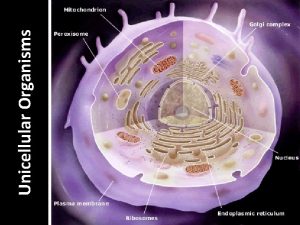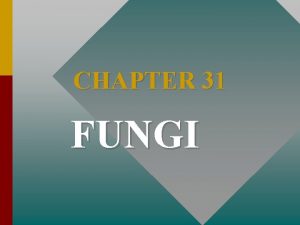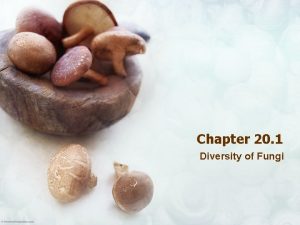Fungi Chapter 31 Fungi Fungi Fungi Fungi Unicellular





















































- Slides: 53

Fungi Chapter 31


Fungi

Fungi

Fungi

Fungi Unicellular Most are multi-cellular Tropics to tundra Aquatics to terrestrial Airborne spores Yeast in breads and beer

Fungi Decomposers Recycle nutrients Help roots of plants absorb nutrients Disease causing (plants and animals) Treatment difficult

Fungi More closely related to animals than plants Common characteristics 1. Heterotrophs Secrete hydrolytic enzymes (exoenzymes) Absorb nutrients(organic molecules)

Fungi 2. Several cell types 3. Dikaryon stage 2 haploid cells coexist in a single cell 4. Cell walls include chitin

Fungi 5. Nuclear mitosis Nuclear envelope does not break down Mitosis takes place in the nucleus Cytokinesis

Body structure Hyphae Tiny filaments Composed of cytoplasm Surrounded by plasma membrane & cell wall Septa Cross-walls that separate cells of hyphae

Hyphae

Fig. 31 -3 Nuclei Cell wall Pore Septum (a) Septate hypha Nuclei (b) Coenocytic hypha

Body structure Mycelium: Mass of connected hyphae Surrounds & infiltrates material Maximizes contact with material Grows rapidly Grows underground so not visible


Reproduction Each cell can have one or more nuclei Monokaryotic: One nuclei Dikaryotic: Two haploid nuclei that function independently

Reproduction Dikaryotic hyphae Heterokaryotic: Nuclei that are from two genetically distinct individuals Homokaryotic: Nuclei are genetically similar

Reproduction Sexually Asexually Spores are produced either way Spread by wind or on insects Suitable environment give rise to new fungal mycelium


Reproduction Sexual reproduction 2 compatible mating types fuse Usually 2 haploid fuse to form diploid Some fungi remain 1 n + 1 n and not 2 n +/- length of time

Reproduction Plasmogamy: Fusion of cytoplasm of mycelia Karyogamy: Fusion of nuclei Zygotes Meiosis Spore formation

Reproduction Asexually Molds Produce haploid spores by mitosis Yeasts Mitosis Buds

Fig. 31 -5 -3 Key Heterokaryotic stage Haploid (n) Heterokaryotic (unfused nuclei from different parents) PLASMOGAMY (fusion of cytoplasm) Diploid (2 n) KARYOGAMY (fusion of nuclei) Spore-producing structures Zygote Spores ASEXUAL Mycelium REPRODUCTION SEXUAL REPRODUCTION MEIOSIS GERMINATION Spores

Nutrients Digest wood (cellulose) Absorb the glucose Lignin (found in wood) Decomposer of living or dead organisms Yield carbon, nitrogen and phosphorus

Nutrients Obtain nutrients from tiny roundworms called nematodes Paralyze Penetrate Absorb nutrients from body Nitrogen source

Metabolic pathways Anaerobic fermentation Wines & cheeses Soy sauce Antibiotics & steroids Yeasts (single cell fungi) Bioremediation Using organisms to break up a toxin

Symbiosis Lichens Fungus & photosynthetic partner (algae) Mutualism some are parasitic Hyphae penetrate cell walls of algae Obtain nutrients from the algae Protects the algae from too much sun

Symbiosis Lichens first to invade a harsh environment Colored - pigments -protect the algae from the sun Pigments are used as natural dyes

Lichen

Mycorrhizae Tree (plant) roots with fungi Fungi function as an extension of roots Plants absorb more nutrients, such as Zn, P, Cu Fungi gets organic materials from the plant

Mycorrhizae 1. Arbuscular: Fungal hyphae penetrate the trees roots Form coils around roots More common 2. Ectomycorrhizae: Hyphae do not penetrate the roots Helps trees grow in infertile areas


Endophytes Fungus lives inside the plant Intercellular spaces Help defend plant against herbivores Symbiotic relationship between fungi & ruminant animals Fungi helps digest the cellulose


Parasitic Mycosis Fungal infection Ringworm Athlete’s foot Candida albicans

Parasitic Aspergillus Produces toxin harmful to humans. Pneumocystis Causes a rare pneumonia in AIDS patients Chytridomycosis Fungal infection that harms amphibians Other fungal infections harm plants Chestnut trees, corn


Fungi Mycologists: scientists that study fungus Five groups 1. Chytrids 2. Zygomycetes 3. Glomeromycetes 4. Ascomycetes 5. Basidiomycetes

1. Chytridiomycota (chytrids) Aquatic fungi Flagellated spores called zoospores Diverged earliest Chitin in the cell walls

2. Zygomycota Bread molds Fruit molds Zygosporangium: Contains one or more diploid nuclei Forms a hard covering Good growth conditions Undergoes meiosis then mitosis Releases spores


Zygomycota Key Haploid (n) Heterokaryotic (n + n) Diploid (2 n) PLASMOGAMY Mating type (+) Mating type (–) Gametangia with haploid nuclei 100 µm Young zygosporangium (heterokaryotic) Rhizopus growing on bread SEXUAL REPRODUCTION Dispersal and germination Sporangia Zygosporangium KARYOGAMY Spores Sporangium ASEXUAL REPRODUCTION MEIOSIS Dispersal and germination 50 µm Mycelium Diploid nuclei

BREAD MOLD

Fig. 31 -6 2. 5 µm

3. Glomeromycetes Arbuscular mycorrhizae Hyphae with plant roots Very few species

4. Ascomycetes Sac fungi Marine, freshwater & terrestrial Yeast Asci: sac like structure containing sexual spores Ascocarps: contain asci Fruiting bodies Microscopic or macroscopic

Ascomycota Conidia; mating type (–) Haploid spores (conidia) Dispersal Germination ASEXUAL REPRODUCTION Key Haploid (n) Dikaryotic (n + n) Diploid (2 n) Mating type (+) Hypha PLASMOGAMY Ascus (dikaryotic) Conidiophore Dikaryotic hyphae Mycelia Mycelium Germination Dispersal Ascocarp Asci SEXUAL REPRODUCTION KARYOGAMY Diploid nucleus (zygote) Eight ascospores Four haploid nuclei MEIOSIS

YEAST

MORELS

TRUFFLES

5. Blasidiomycetes Mushrooms, shelf fungi, puff balls Blasidium (Latin means “little pedestal”) Long-lived dikaryotic mycelium Leads to more genetic re-combinations Blasidiocarps (mushroom) Produced sexually Fruiting bodies Wood decomposers

Blasidiomycetes Dikaryotic mycelium PLASMOGAMY Haploid mycelia Mating type (–) Haploid mycelia Mating type (+) Gills lined with basidia SEXUAL REPRODUCTION Basidiocarp (n+n) Dispersal and germination Basidiospores (n) Basidium with four basidiospores Basidium Basidia (n+n) Basidium containing four haploid nuclei KARYOGAMY MEIOSIS Key 1 µm Basidiospore Diploid nuclei Haploid (n) Dikaryotic (n +n) Diploid (2 n)

 Is a sunflower unicellular or multicellular
Is a sunflower unicellular or multicellular Simple definition of unicellular
Simple definition of unicellular Unicellular and multicellular organisms venn diagram
Unicellular and multicellular organisms venn diagram Archaea kingdoms
Archaea kingdoms Basidiospora
Basidiospora Are fungi single celled or multicellular
Are fungi single celled or multicellular Is kingdom fungi unicellular or multicellular
Is kingdom fungi unicellular or multicellular Organism
Organism Diatoms unicellular or multicellular
Diatoms unicellular or multicellular Multicellular organisms images
Multicellular organisms images Autotrophic eukaryotes
Autotrophic eukaryotes Is eubacteria multicellular or unicellular
Is eubacteria multicellular or unicellular Is yeast multicellular or unicellular
Is yeast multicellular or unicellular Multicellular organisms examples
Multicellular organisms examples Kingdom protista members
Kingdom protista members Protists unicellular or multicellular
Protists unicellular or multicellular Protista is unicellular or multicellular
Protista is unicellular or multicellular Sparophytes
Sparophytes Unicellular organism
Unicellular organism Absorptive nutrition in fungi
Absorptive nutrition in fungi Why do unicellular organisms divide
Why do unicellular organisms divide Archaebacteria multi or unicellular
Archaebacteria multi or unicellular Ciri ciri chara
Ciri ciri chara Escherichia coli unicellular or multicellular
Escherichia coli unicellular or multicellular Characteristics of protists
Characteristics of protists Unicellular organisms
Unicellular organisms 6 kingdoms of life
6 kingdoms of life Are thermoacidophiles unicellular or multicellular
Are thermoacidophiles unicellular or multicellular Unicellular cell division
Unicellular cell division Is a venus fly trap unicellular or multicellular
Is a venus fly trap unicellular or multicellular Porphyra unicellular or multicellular
Porphyra unicellular or multicellular Unicellular heterotrophs
Unicellular heterotrophs White piedra
White piedra Unicellular prokaryotes kingdom
Unicellular prokaryotes kingdom Is volvox autotrophic or heterotrophic
Is volvox autotrophic or heterotrophic Unicellular adaptations
Unicellular adaptations What are trees
What are trees Verzeala zidurilor
Verzeala zidurilor Give an example for unicellular organism
Give an example for unicellular organism Euglena unicellular or multicellular
Euglena unicellular or multicellular Are archaebacteria unicellular or multicellular
Are archaebacteria unicellular or multicellular Protozoa unicellular or multicellular
Protozoa unicellular or multicellular Are protists polyphyletic
Are protists polyphyletic Phyrophyta
Phyrophyta Unicellular vs multicellular activity
Unicellular vs multicellular activity Sporozans
Sporozans Carl linnaeus
Carl linnaeus How are unicellular and multicellular organisms alike
How are unicellular and multicellular organisms alike The smallest grouping that can interbreed.
The smallest grouping that can interbreed. What do unicellular organisms do to maintain homeostasis
What do unicellular organisms do to maintain homeostasis Categorize the following organisms as unicellular (u)
Categorize the following organisms as unicellular (u) Unicellular marine organisms
Unicellular marine organisms Unicellular organisms
Unicellular organisms Is a starfish unicellular or multicellular
Is a starfish unicellular or multicellular


